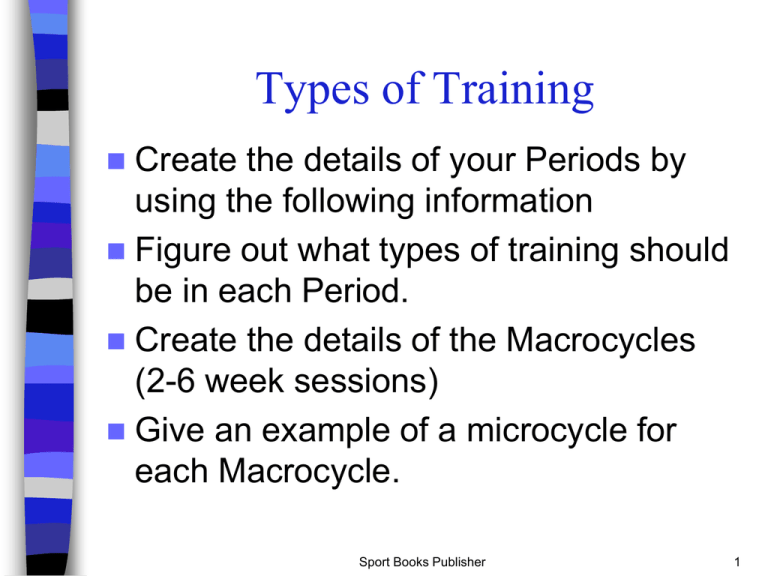Types of training for Macrocycles
advertisement

Types of Training Create the details of your Periods by using the following information Figure out what types of training should be in each Period. Create the details of the Macrocycles (2-6 week sessions) Give an example of a microcycle for each Macrocycle. Sport Books Publisher 1 Overview of fitness training methods and their effects Sport Books Publisher 2 Circuit Training Sport Books Publisher 3 Circuit Training exercises all major intensity, volume, muscle groups in one and rest intervals can session be manipulated effective for general fitness development Sport Books Publisher 4 Sport Books Publisher 5 Principles of Circuit Exercise Programs Major variables to be considered: Number of exercises Sequence of exercises Length of rest period between sets Length of rest period between circuits Types of exercises Resistance levels Sport Books Publisher 6 Principles of Circuit Exercise Programs The number of exercises per muscle group depends on: The training effect to be achieved The desired volume of work to be completed during a training session The desired intensity of effort The structure of the program Sport Books Publisher 7 Principles of Circuit Exercise Programs The trainee progresses from one exercise station to another in sequence A given number of repetitions are performed at each exercise station Active recovery of previously used muscles occur from station to station Sport Books Publisher 8 Principles of Circuit Exercise Programs A circuit may include running laps between stations The effect of this type of training is the development of both muscular and cardiorespiratory fitness Sport Books Publisher 9 Cardiorespiratory Training 1. Endurance training 2. Fartlek training 3. Interval training 4. Repetition training Sport Books Publisher 10 Endurance Training Also known as continuous training or slow long distance (SLD) training Involves training at approximately 40-60% of max. performance ability over a long distance Typically carried out without break Physiological benefits include enhanced aerobic capacity Psychological benefits - increased determination and self-confidence The major objective - to develop a solid fitness base during the preparatory season Sport Books Publisher 11 Sport Books Publisher 12 Fartlek Training Endurance training method used by runners mainly during the preparatory season Combines long slow distance training, pace/tempo training and interval training It involves easy running, fast bursts of running of varying lengths, hill running Sport Books Publisher 13 Interval Training Involves systematic alteration of exertion and recovery a. Extensive Interval b. Intensive Interval Sport Books Publisher 14 A. Extensive Interval Requires the trainee to carry out a great number of repetitions of selected distance in one session with a recovery period equal to the work interval Keeping the work-to-rest ratio (W:R) at 1:1-2 between intervals and 1:2-4 between sets Each exercise is repeated 20-30 times The repetitions are divided into several sets The training intensity is between 60-80 percent of the trainee’s max. performance Sport Books Publisher 15 Sport Books Publisher 16 Intensive Interval – high intensity Overall lower training volume than the extensive interval method Each interval is repeated 10-20 times Performed at 80-90 percent of the trainee’s max performance capacity Requires longer breaks: W:R is approximately 1:2-3 between intervals and 1:4-6 between sets Should not be implemented until a solid fitness base of aerobic training has been attained Sport Books Publisher 17 Sport Books Publisher 18 Repetition Training – race pace Also known as tempo training Conducted at maximal intensity levels Used in the final preparations for competition The duration of exercise is normally longer than in interval training Longer recovery periods are needed between individual bouts W:R is approximately 1:5 or longer Sport Books Publisher 19 Sport Books Publisher 20 Combination Training Simultaneously develop both muscular and cardiorespiratory fitness A. Combo Circuit Training B. Cross Training Sport Books Publisher 21 Combo Circuit Training In addition to strength exercises, a circuit may include running laps between stations Distance of the running may vary between 50-400 metres depending on the available facility and specific needs of the trainee Sport Books Publisher 22 Cross Training Involves activities that offer aerobic fitness benefits similar to those offered by running. It can also promote total body fitness and may prevent overuse injuries Used by competitive athletes during the transition period A. Aerobic cross training (cycling, swimming) B. Muscular endurance cross training (rowing machine, StairMaster) C. Activity cross training (several different activities) Sport Books Publisher 23 Summary Physical fitness - strength, power, endurance, flexibility, body composition, and psychomotor abilities Cardiorespiratory endurance enhanced through endurance, Fartlek, interval training, and repetition training Flexibility can be improved by static stretching, dynamic stretching, and proprioceptive neuromuscular facilitation (PNF) Sport Books Publisher 24





